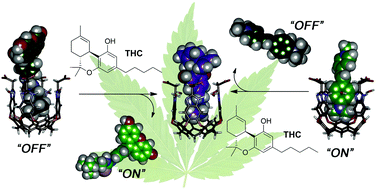Adam D. Gill, Briana L. Hickey, Wenwan Zhong and Richard J. Hooley
Chem. Commun., 2020,56, 4352-4355
DOI:
10.1039/D0CC01489C,
Communication
A water-soluble host molecule can bind tetrahydrocannabinol (Δ9-THC) and its metabolites in aqueous solution. By pairing this recognition event in a sensing array with fluorescent reporters and varying external mediators, pattern recognition-based detection is possible, which allows selective discrimination of the THC metabolites. The selective sensing can be performed in aqueous solution with micromolar sensitivity, as well as in biofluids such as urine and saliva. Metabolites as similar as Δ8- and Δ9-THC, differing only in the position of a double bond, can be distinguished.
